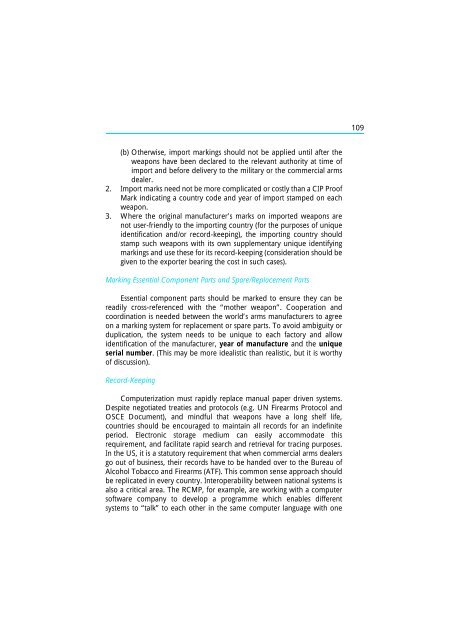The Scope and Implications of a Tracing Mechanism for Small Arms ...
The Scope and Implications of a Tracing Mechanism for Small Arms ...
The Scope and Implications of a Tracing Mechanism for Small Arms ...
Create successful ePaper yourself
Turn your PDF publications into a flip-book with our unique Google optimized e-Paper software.
109<br />
(b) Otherwise, import markings should not be applied until after the<br />
weapons have been declared to the relevant authority at time <strong>of</strong><br />
import <strong>and</strong> be<strong>for</strong>e delivery to the military or the commercial arms<br />
dealer.<br />
2. Import marks need not be more complicated or costly than a CIP Pro<strong>of</strong><br />
Mark indicating a country code <strong>and</strong> year <strong>of</strong> import stamped on each<br />
weapon.<br />
3. Where the original manufacturer’s marks on imported weapons are<br />
not user-friendly to the importing country (<strong>for</strong> the purposes <strong>of</strong> unique<br />
identification <strong>and</strong>/or record-keeping), the importing country should<br />
stamp such weapons with its own supplementary unique identifying<br />
markings <strong>and</strong> use these <strong>for</strong> its record-keeping (consideration should be<br />
given to the exporter bearing the cost in such cases).<br />
Marking Essential Component Parts <strong>and</strong> Spare/Replacement Parts<br />
Essential component parts should be marked to ensure they can be<br />
readily cross-referenced with the “mother weapon”. Cooperation <strong>and</strong><br />
coordination is needed between the world’s arms manufacturers to agree<br />
on a marking system <strong>for</strong> replacement or spare parts. To avoid ambiguity or<br />
duplication, the system needs to be unique to each factory <strong>and</strong> allow<br />
identification <strong>of</strong> the manufacturer, year <strong>of</strong> manufacture <strong>and</strong> the unique<br />
serial number. (This may be more idealistic than realistic, but it is worthy<br />
<strong>of</strong> discussion).<br />
Record-Keeping<br />
Computerization must rapidly replace manual paper driven systems.<br />
Despite negotiated treaties <strong>and</strong> protocols (e.g. UN Firearms Protocol <strong>and</strong><br />
OSCE Document), <strong>and</strong> mindful that weapons have a long shelf life,<br />
countries should be encouraged to maintain all records <strong>for</strong> an indefinite<br />
period. Electronic storage medium can easily accommodate this<br />
requirement, <strong>and</strong> facilitate rapid search <strong>and</strong> retrieval <strong>for</strong> tracing purposes.<br />
In the US, it is a statutory requirement that when commercial arms dealers<br />
go out <strong>of</strong> business, their records have to be h<strong>and</strong>ed over to the Bureau <strong>of</strong><br />
Alcohol Tobacco <strong>and</strong> Firearms (ATF). This common sense approach should<br />
be replicated in every country. Interoperability between national systems is<br />
also a critical area. <strong>The</strong> RCMP, <strong>for</strong> example, are working with a computer<br />
s<strong>of</strong>tware company to develop a programme which enables different<br />
systems to “talk” to each other in the same computer language with one
















